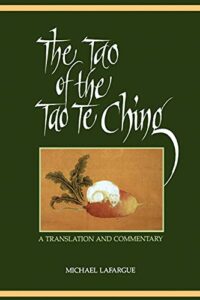BY MICHAEL LAFARGUE
ALBANY, NEW YORK: SUNY PRESS, 1992
270 PAGES
 My undergraduate students and I just finished carefully reading Michael LaFargue’s The Tao of the “Tao Te Ching”, line by line. LaFargue’s book is the first study of this seminal text to utilize fully the methodology of textual criticism developed mainly within Biblical studies. This method provides an extremely useful and much needed contextualization of the Tao Te Ching within the specific historical, religious and social conditions of ancient China.
My undergraduate students and I just finished carefully reading Michael LaFargue’s The Tao of the “Tao Te Ching”, line by line. LaFargue’s book is the first study of this seminal text to utilize fully the methodology of textual criticism developed mainly within Biblical studies. This method provides an extremely useful and much needed contextualization of the Tao Te Ching within the specific historical, religious and social conditions of ancient China.
Combining methods of both form and redaction criticism, LaFargue analyzes each chapter of the text and shows how the “editors” have interwoven polemic aphorisms, recurrent religious themes, and loose strands of Chinese folk wisdom into a coherent, yet irredeemably composite, whole. He has, moreover, rearranged the order of the chapters according to topic, highlighting the recurrent themes found throughout the text. This method entails, to be sure, considerable textual “slicing and dicing,” which can be disconcerting for some since it undermines the sanctity of the form and content of the received text. This was precisely the reason I chose LaFargue’s work as the main primary text in a course on Chinese and Japanese religions. It clearly demonstrates through the nuts and bolts of historical methodology how “the ideas that we find in scriptural writings did not fall from the sky. They grew out of human experience” (xv). To this end, in a series of short essays appended to the translation, LaFargue outlines not only the methodology of textual criticism, but more importantly, he recounts the historical milieu and originating intentions of the text’s editors/authors, whom he identifies as a community of alienated yet aspiring political leaders and moralists called shih (192).1
While this may sound quite formidable for undergraduate students, the material is so skillfully arranged that the scholarship seldom obscures the text itself. The translation of the Tao Te Ching and LaFargue’s textual commentary can easily be read separately or together. The translation of each chapter appears on the left-hand page, facing a modern paraphrase and textual or contextual comments on the right-hand side. His wonderfully understated interpretations of the content of each chapter were much appreciated by the students. Moreover, each distinct saying is unobtrusively demarcated and cross-referenced, where appropriate, to similar sayings throughout the text, thereby helping students study specific themes which could otherwise only painstakingly be pieced together. The students initially found the thematic arrangement rather repetitive. By the time we finished the book, however, they found it very helpful for studying and reviewing, since they could so readily trace each theme and its various nuances as it threads its way through the text.
LaFargue’s novel arrangement also brought out an interesting and ironic aspect of the text which is considerably less conspicuous in the traditional arrangements: the Tao Te Ching is a very polemical text. It ‘contends’ in almost every chapter! So much so that my students were able to use this book as a chief source in a debate between the Taoists and Confucianists—not just for the Taoist positions, but for many Confucian and Legalist points as well! Again, this was possible only because LaFargue has so thoroughly contextualized the Tao Te Ching within the contemporary Warring State Period (463–222 B.C.E.) But, as with the scholarship, far from detracting from the text itself, this historical information is so unobtrusive that I had to point out its import to the students again and again. LaFargue, it would seem, contends even less than Lao Tzu himself!
Mere mention of Lao Tzu himself suggests several lacunas in the book, compared, that is, with more traditional treatments of the Tao Te Ching. Consistent with LaFargue’s stated aim of recovering the contemporaneous meanings of the text, the historical authorship of Lao Tzu is nowhere seriously entertained, nor are the more cosmological readings of later Chinese traditions prominent in LaFargue’s commentaries. To the extent that I found these latter perspectives worthwhile, I supplemented the book with outside materials, attempting to maintain the important distinction,
however, between a historical approach to the origins of the text and an appreciation of its later position within Chinese religious history as a whole.
In the end, I feel sure the students will never read the Tao Te Ching, nor any other religious text, quite the same way again. LaFargue provides a ‘softlanding’ into the rigors and rewards of textual criticism without irreparably destroying the religious import of this marvelous text. This is particularly apropos, since the imperatives of historical scholarship exemplify the simplest, yet most profound, message of the Tao Te Ching itself: things exist in context, only within which do they gain their life and meaning. For those wishing such a window onto the Lebenswelt of early China, I strongly recommend Michael LaFargue’s The Tao of the “Tao Te Ching.”
1. A more in-depth treatment of these methodological and historical issues can be found in LaFargue’s Tao and Method: A Reasoned Approach to the “Tao Te Ching”, also by SUNY Press, 1994.

